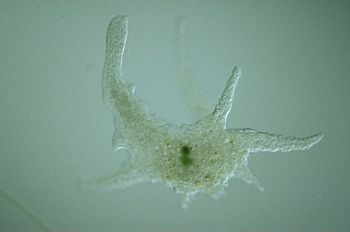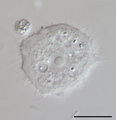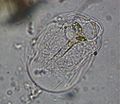Amoebozoa facts for kids
Quick facts for kids AmoebozoaTemporal range: 1000–0Ma
|
|
|---|---|
 |
|
| Chaos carolinensis | |
| Scientific classification |
|
| Domain: | Eukaryota |
| (unranked): | Unikonta |
| Phylum: | Amoebozoa Lühe, 1913 emend. Cavalier-Smith, 1998 |
| Subphyla, infraphyla and classes | |
|
|
| Synonyms | |
|
|
The Amoebozoa are a eukaryote phylum of Amoeba-like protozoa. Most move by internal cytoplasmic flow. Their finger-like pseudopodia are characteristic.
They are a major group with about 2,400 described species of amoeboid protists. In most classification schemes, Amoebozoa is ranked as a phylum in either the kingdom Protista or the kingdom Protozoa. In the classification of the International Society of Protistologists, it is kept as an unranked "supergroup" in the Eukaryota.
Sequence analysis shows Amoebozoa is a monophyletic clade. Most phylogenetic trees identify it as the sister group to Opisthokonta. That is another major clade which contains both Fungi and Animals as well as some 300 species of unicellular protists. Amoebozoa and Opisthokonta are sometimes grouped together in a high-level taxon, variously named Unikonta, Amorphea, or Opimoda.
Amoebozoa includes many of the best-known amoeboid organisms, such as Chaos, Entamoeba, Pelomyxa and the genus Amoeba itself.
Most are unicellular, and are common in soils and aquatic habitats. Some are symbionts of other organisms, including several pathogens. The Amoebozoa also include the mycetozoan slime moulds, multinucleate or multicellular forms which produce spores and are usually visible to the unaided eye.
The nutrition is usually by phagocytosis. The cell surrounds food particles, sealing them into vacuoles where they are digested and absorbed. When food is scarce, most species form cysts, which may be carried by air to other places. In slime moulds, these structures are called spores, and form on stalked structures called fruiting bodies or sporangia.
Most Amoebozoa lack flagella and more generally do not form microtubule-supported structures except during mitosis. However, flagella occur among some archamoebae, and many slime moulds produce biflagellate gametes.
A characteristic form is the model organism Dictyostelium discoideum.
Images for kids
-
Entamoeba histolytica trophozoite (Conosa: Archamoebae)
-
Dictyostelium discoideum (Conosa: Dictyostelia)
See also
 In Spanish: Amoebozoa para niños
In Spanish: Amoebozoa para niños










